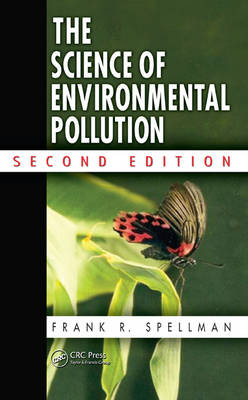
The Science of Environmental Pollution, Second Edition
Crc Press Inc (Verlag)
978-1-4398-1302-7 (ISBN)
- Titel ist leider vergriffen;
keine Neuauflage - Artikel merken
Hailed on its first publication as a masterly addition to its companion volumes The Science of Water and The Science of Air, The Science of Environmental Pollution, Second Edition successfully completes the process of bringing this series into the twenty-first century. This new edition continues to ask the same questions about environmental pollution: What is it? What is its impact? What are the causes and how can we mitigate them? But more than this, the second edition stimulates new ways to think about the issues and their possible solutions.
Simply put, studying pollution without science is analogous to attempting to cook without being able to read a recipe, measure ingredients correctly, or monitor the progress of that which is cooking. Conversely, studying pollution through science affords the opportunity to maintain a healthful, life-sustaining environment. This second edition of a bestseller presents common-sense approaches and practical examples based on scientific principles, models, and observations, but keeps the text lively and understandable to scientists and non-scientists alike.
The Second Edition contains:
Completely revised and updated information in every chapter
New material on pharmaceuticals in water
New material on water scarcity
Environmental issues continue to attract attention at all levels. Some sources say that pollution is the direct cause of climate change; others deny that the possibility even exists. This text sorts through the hyperbole, providing concepts and guidelines that not only aid in understanding the issues, but equip you with the scientific rationale required to make informed decisions.
Old Dominion University, Norfolk, Virginia, USA
Introduction
Pollution: What Is It?
Introduction
Pollution Defined
Pollution: Effects Often Easy to See, Feel, Taste, or Smell
Pollution and Environmental Science/Health
Environmental Pollution and Technology: The Connection
Science and Technology Offer Solutions
The Bottom Line
Discussion Questions
References and Recommended Reading
Pollution Science Fundamentals
Introduction
Biogeochemical Cycles
Energy Flow through an Ecosystem and the Biosphere
Units of Measurement
The Bottom Line
Discussion Questions
References and Recommended Reading
Global Pollution: The Problem
Introduction
Global Interdependence
Global Pollution Problems: Causal Factors
Pollution and Global Environmental Degradation
So, What Is the Answer?
Discussion Questions
References and Recommended Readings
Sources of Pollution
A Historical Perspective
Introduction
Natural Pollutants
Pollutant Terminology
Soil, Water, and Air Pollution: The Interface
Discussion Questions
References and Recommended Reading
Air
Air
Introduction
All About Air
The Components of Air: Characteristics and Properties
Air for Combustion
Air for Power
Stratification of the Atmosphere
Physical Properties and Dynamics of Air
Gas Laws
Gas Conversions
Gas Velocity
Gas Stream Treatment (Residence) Time
Gas Density
Heat Capacity and Enthalpy
Heat and Energy in the Atmosphere
Adiabatic Lapse Rate
Viscosity
Flow Characteristics
Particle Physics
Characteristics of Particles
Particle Formation
Collection Mechanisms
Atmospheric Dispersion, Transformation, and Deposition
The Bottom Line
Discussion Questions
References and Recommended Reading
Air Pollution
Yurk and Smilodon
Introduction
Problems of Atmospheric Pollution
The Bottom Line
Discussion Questions
References and Recommended Readings
Air Pollution Remediation
Introduction
Clearing the Air
Air Pollution Control: Choices
Air Pollution Control Equipment and Systems
Removal of Dry Particulate Matter
Removal of Gaseous Pollutants: Stationary Sources
Removal of Gaseous Pollutants: Mobile Sources
The Bottom Line
Discussion Questions
References and Recommended Reading
Water
Water
Water: Earth’s Blood
Water: Facts and Prose
Water: The Basics
How Special, Strange, and Different Is Water?
Characteristics of Water
Water’s Physical Properties
Capillary Action
The Water Cycle
Specific Water Movements
Q and Q Factors
Sources of Water
Watershed Protection
Potable Water Source
Surface Water
Groundwater Supply
Well Systems
Water Use
The Bottom Line
Discussion Questions
References and Recommended Reading
Water Pollution
Case Study 9.1. Chesapeake Bay
Introduction
Surface Water
Setting the Stage
Surface Water Pollutants
Groundwater Pollution
Wetlands
The Bottom Line on Surface Water and Groundwater Pollution
Discussion Questions
References and Recommended Reading
Water Pollution: Remediation
Historical Prospective
Effect of Regulations on Preventing Water Pollution
A Sherlock Holmes at the Pump
Water Treatment
Wastewater Treatment
Thermal Pollution Treatment
Pollution Control Technology: Underground Storage Tanks
Pollution Control Technology: Groundwater Remediation
The Bottom Line
Discussion Questions
References and Recommended Reading
Soil
Soil Basics
Introduction
Soil: What Is It?
Key Terms Defined
All About Soil
Functions of Soil
Soil Basics
Soil Formation
Soil Characterization
Soil Mechanics and Physics
Soil Chemistry
Solid Wastes
The Bottom Line
Discussion Questions
References and Recommended Reading
Soil Pollution
Clean Soil
Soil Pollutants: Transport Mechanisms Affecting Flow Regime
The Basics of Soil Pollution
Industrial Practices and Soil Contamination
Hazardous Substances
Hazardous Wastes
Hazardous Waste Legislation
The Bottom Line
Discussion Questions
References and Recommended Reading
Soil Pollution Remediation
Introduction
USTs: The Problem
Risk Assessment
Exposure Pathways
Remediation of UST-Contaminated Soils
Economic Outlook
Animal Feeding Operations and Animal Waste Treatment
Waste Control Technology
Ultimate Disposal
Green Remediation
The Bottom Line
Discussion Questions
References and Recommended Reading
Pollution and the 21st Century
Glossary
Index
| Erscheint lt. Verlag | 10.12.2009 |
|---|---|
| Zusatzinfo | 300-400 equations; 38 Tables, black and white; 95 Illustrations, black and white |
| Verlagsort | Bosa Roca |
| Sprache | englisch |
| Maße | 156 x 235 mm |
| Gewicht | 839 g |
| Themenwelt | Naturwissenschaften ► Biologie ► Ökologie / Naturschutz |
| Naturwissenschaften ► Geowissenschaften ► Geologie | |
| ISBN-10 | 1-4398-1302-7 / 1439813027 |
| ISBN-13 | 978-1-4398-1302-7 / 9781439813027 |
| Zustand | Neuware |
| Haben Sie eine Frage zum Produkt? |
aus dem Bereich


